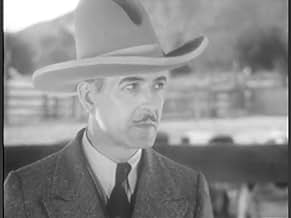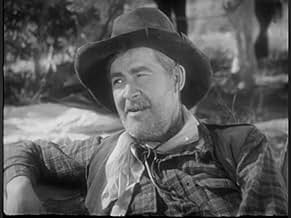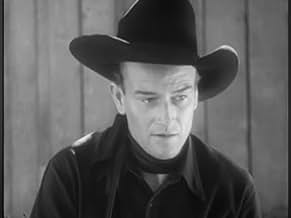Agrega una trama en tu idiomaTed Hayden impersonates a wanted man and joins Gentry's gang only to learn later that Gentry was the one who killed his father. He saves Virginia Winters' dad's ranch from Gentry and also re... Leer todoTed Hayden impersonates a wanted man and joins Gentry's gang only to learn later that Gentry was the one who killed his father. He saves Virginia Winters' dad's ranch from Gentry and also rescues his long-lost brother Spud.Ted Hayden impersonates a wanted man and joins Gentry's gang only to learn later that Gentry was the one who killed his father. He saves Virginia Winters' dad's ranch from Gentry and also rescues his long-lost brother Spud.
- Dirección
- Guionistas
- Elenco
- Fay Winters
- (as Virginia Faire Brown)
- Dusty Rhodes
- (as George Hayes)
- Mr. Gentry
- (as Loyd Whitlock)
- Spud Hayden
- (as Billie O'Brien)
- Cattle Buyer Hornsby
- (sin créditos)
- Doctor Silsby
- (sin créditos)
- Henchman
- (sin créditos)
- Henchman
- (sin créditos)
- Henchman
- (sin créditos)
- Henchman
- (sin créditos)
- Henchman Butch
- (sin créditos)
- Dirección
- Guionistas
- Todo el elenco y el equipo
- Producción, taquilla y más en IMDbPro
Opiniones destacadas
There's a few good scenes and a decent climax in this entry in Wayne's Lone Star western series but mostly this is middle of the road entertainment with a bit too much talking and not enough action this time around.
However, this does have some better-than-usual acting for the series. Duke and Gabby's performances are also quite likable, as is the actor that played Wayne's young friend.
At one point, Wayne turns to the bad guy and says that he's acting like a character out of a dime novel. He's exactly right. The bad guy and the story are stereotypes even for 1933.
The series seems to move between films that basically follow straight stereotypical Western stories and films that provide funny and clever twists on the stereotypical stories. This one is played straight and thus only has interest for cinema or Western historians. The other type ("Riders of Destiny" and "the Star Packer," for example) are still quite entertaining 75 years later.
The film opens with a piece of good luck coming their way in the person of the dying gunman Gatt Ganns who's been hired by Lloyd Whitlock to kill rancher Lafe McKee. Of course Whitlock is once again a villain in the Snidely Whiplash tradition who not only wants the ranch, but also has evil designs on McKee's daughter Virginia Brown Faire.
In reviewing B westerns, sometimes I have a tendency to reach back to those 19th century morality plays so popular in that era. Whitlock in fact even laughs like a villain in one of those plays. For reference you should see the Irene Dunne-Allan Jones version of Showboat to see just the kind of drama they used to put on then. It survived in the B western, John Wayne's as well as other's.
Wayne of course by the end solves all the problems concerned and the villain gets his just desserts. We can't say how though.
The Duke pretends to be the recently deceased Mr. Ganns to get the goods on the bad guys along with sidekick Gabby Hayes. He discovers a young kid being raised by one of the outlaws. Interesting in this B western set firmly in the 19th century morality play tradition, we also have a topic so very gingerly touched on as child abuse. A rather adult theme for a western or any kind of picture at that time.
Wayne was just beginning his stay at Monogram Pictures Lone Star westerns, this was his third. Monogram had a stock company to rival the much better one of John Ford. Note how for the next three or four years, the casts are just about the same in every Wayne western at that studio. It gets hard to keep these in chronological order, I wouldn't be surprised if a few of these weren't shot simultaneously.
The best you can say about the Monogram films is that they kept John Wayne employed, not something easily said during the Depression. And they beat those serials he did for Mascot. West of the Divide will never be on any John Wayne fans top 10 list.
Rather than having a five-minute prologue to the situation involving the central character as a 12-year-old boy, production values save time and cost by opening the story revolving the now adult Ted Hayden (John Wayne) accompanied by his friend, "Dusty" Rhodes (George "Gabby" Hayes, minus his beard that would later make him famous) resting out in the wilderness discussing the murder of Hayden's father when he was a boy. Left for dead, Ted is said to be found and taken in by Dusty, who, after two years under his care, has brought him back to heath. Ted also has a little brother whose mother died at the time of his birth, and wants to find him. During this reminiscing of the past leading to both men returning to the scene of the crime, Ted and Dusty notice a man stumbling to the ground, dying after drinking poisoned water. Finding an envelope on his person, they find the deceased to be Gat Ganns, a wanted killer with a $5,000 reward for his capture. Convinced of Ganns association with Jeffrey Gentry (Lloyd Whitlock), the man who bought his father's ranch, to be responsible for his father's death and brother's abduction, Ted, who bears a close resemblance to the deceased, poses Ganns to work under Gentry to see if his hunch is correct. In the meantime, Gentry, losing his bid to buy the ranch belonging to Fred Winters (Lafe McKee) and his daughter, Fay (Virginia Browne-Faire), schemes to get that ranch regardless. He has two of his henchmen to follow and rob Fay of the $3,000 for bank deposit to ruin for father financially. Accidentally shot while hiding in an abandoned barn, Fay is later found unconscious by Ted, who takes her to Doctor Silsby (Philip Kieffer) for treatment. Having found her money, Ted deposits it for her in secret at the bank. Now working for Gentry to do away with Winters, Ted later saves Spud (Billy O'Brien), a 12-year-old boy from a runaway coach and from the brutal whipping by his brutal father, Butch (Blackie Whitford. The closer Ted gets to his father's murder, the more his life is in danger. Other supporting players include Yakima Canutt, Earl Dwire and Horace B. Carpenter.
As with many of Wayne's early westerns, he bonds well with his co-stars, Virginia Browne-Faire, and youngster, played by Billy (billed Billie) O'Brien, another good reason the film works so well. Even with lack of production values, it still has charm. Chances are the plot summary had been used earlier or later with other western actors, but it's John Wayne, better known as "The Duke," who's the reason this and other his early westerns have remained watchable long after its theatrical releases.
Distributed on video cassette in the 1980s, the decade where this and other of Wayne's Lone Star westerns frequently played for a while on public television, WEST OF THE DIVIDE, also available on DVD, has had its cable television presentations, namely American Movie Classics (1996-2000) and Encore Westerns. Beware of prints with new and poorly constructed underscoring used during opening and closing credits, along with scoreless scenes that would be rough sledding for viewers to stop watching long before the movie comes to a close. (**1/2)
¿Sabías que…?
- TriviaIn 1934, this film was condemned by the Catholic Legion of Decency.
- ErroresDuring a fight between Ted Hayden and Butch, Spuds shouts, "Come on, Ted!" Actually, Ted has been introduced to him and all others at the gangsters' hide-out as Gat Ganns. His real identity is in fact revealed later.
- Citas
Doctor Silsby: You got her here just in time. A small artery's been severed. However, I don't think it's very serious.
- Versiones alternativasFox/Lorber Associates, Inc. and Classics Associates, Inc. copyrighted a version in 1985 with a new original score composed and orchestrated by William Barber. It was distributed by Fox/Lorber and ran 48 minutes.
- ConexionesEdited into Six Gun Theater: West of the Divide (2016)
Selecciones populares
- How long is West of the Divide?Con tecnología de Alexa
Detalles
- Tiempo de ejecución54 minutos
- Color
- Mezcla de sonido
- Relación de aspecto
- 1.37 : 1
Contribuir a esta página

































